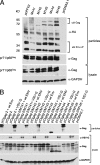Basic residues in the foamy virus Gag protein
- PMID: 21289113
- PMCID: PMC3126134
- DOI: 10.1128/JVI.01906-10
Basic residues in the foamy virus Gag protein
Abstract
Foamy virus (FV) capsid proteins have few lysines. Basic residues are almost exclusively represented by arginines indicating positive selective pressure. To analyze the possible functions of this peculiarity, we mutated an infectious molecular clone of the prototypic FV (PFV) to harbor lysines in the Gag protein at arginine-specifying positions and analyzed various aspects of the FV replication cycle. The majority of mutants replicated equally as well in permanent cell cultures as the original wild-type (wt) virus and were genetically stable in gag upon 10 cell-free passages. With respect to the features of late reverse transcription, nucleic acid content, and infectiousness of the virion DNA genome, the majority of mutants behaved like the wt. Several mutants of PFV were ubiquitinated in Gag but unable to generate virus-like particles (VLPs) or to undergo pseudotyping by a heterologous envelope. Using primary cells, however, a replicative disadvantage of the majority of mutants was disclosed. This disadvantage was enhanced upon interferon (IFN) treatment. We found no evidence that the lysine-bearing gag mutants showed more restriction than the wt virus by tetherin (CD317) or Trim5α. A single lysine in PFV Gag was found to be nonessential for transient replication in permanent cell culture if replaced by an arginine residue. Upon replication in primary cells, even without IFN treatment, this mutant was severely impaired, indicating the importance of specifying at least this lysine residue in PFV Gag. The paucity of lysines in FV Gag proteins may be a consequence of preventing proteasomal Gag degradation.
Figures



References
-
- Ausubel F. M., et al. 1987. Current protocols in molecular biology. John Wiley, New York, NY
-
- Bender A., van Dooren G. G., Ralph S. A., McFadden G. I., Schneider G. 2003. Properties and prediction of mitochondrial transit peptides from Plasmodium falciparum. Mol. Biochem. Parasitol. 132:59–66 - PubMed
Publication types
MeSH terms
Substances
LinkOut - more resources
Full Text Sources

